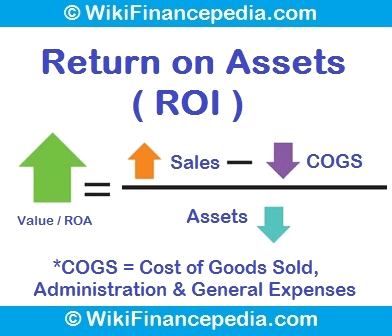Return on Assets Ratio Definition:
Appraisal of net income produced by total assets during the computing period is called Return on assets ratio. Often it’s also called return on total assets ratio and it is computed by evaluating the net income of a company with respect to the average total assets. In other words, the efficiency of a company or its management team in managing their entire assets, both fixed and current in order to maximize the revenue during a particular period is determined by return on asset ratio.
Now that you’re aware about the definition of ROA (Return on Assets), you should know that this measurement is often considered by both management and investors to supervise company’s ability to convert investments in assets and finally generating profit from it. The reason why this makes sense is because company assets’ exclusive purpose is to generate revenues and maximize profits. ROA ratio can also be represented as a product of the profit margin and the total asset turnover. This formula can be used to calculate the return on total assets.
You can also understand ROA as a return on investment for the company, because generally capital assets are often the most significant investment for majority of companies. In this case, return is measured in profit as the investment made by the company in capital assets is in form of money.
Return on Assets Ratio is also known as Return on Total Assets. Long story short, this ratio is a measurement of assets’ profitability.
Return on Assets Analysis:
Let’s recall the purpose of the return on assets ratio. It measures the proficiency of a company, as to how well can they manage their assets to earn return on its investment. In other words, ROA determines how resourcefully a company can convert the money employed to acquire assets into net income or profits.
Owing to the funding of all the assets by either equity or debt, often a few investors add back interest expense in the formula and take no notice of the costs involved during acquiring the assets in the return calculation.
Now, we know that it will only make sense if the return on assets ratio is higher. Imagine yourself, higher ratio will be favored by investors any day for it reflects the efficiency of a company to manage their assets by the book and generate greater amounts of net income. Also, a positive ROA ratio normally signifies an upward profit trend. ROA is helpful in comparing companies in the same industry as well, since different industries use assets in different proportions. Let’s say automobile companies use large, expensive and technical equipment, mostly hardware while software companies use computers and software’s.
Return on Assets Formula:
The return on assets ratio formula is calculated by dividing net income by average total assets. This ratio also corresponds to the total asset turnover and product of the profit margin.
Either formula can help you find out the return on total assets. Generally, average total assets are preferred because asset totals can fluctuate during the accounting year. You don’t have to do a lot, just sum up the beginning and ending assets on the balance sheet and divide the answer by two, and there you’ll have your average assets for the year. It might be obvious, but at the same time it is significant to mention that average total assets are the historical cost of the assets on the balance sheet, and the accumulated depreciation is not considered.
Return on Assets Examples:
Let’s take an example and calculate the ROA:-
Suppose the Indie tech is no more a start-up, it is a growing tech company. Indie has a contract to develop a few apps and softwares for some MNC. The former one’s balance sheet shows beginning assets of INR 1,000,000 and an ending balance of INR 2,000,000 of assets. During the current year, Indie had net income of INR 20,000,000. Their return on assets ratio will be INR 133.33.
As you can see, Indie’s ROA is 1,333.3 percent. In other words, every rupee invested by Indie in assets during the year produced INR 13.3 of net income. This can be considered as healthy return rate, albeit depending on the economy.
Indie has a favorable ROA and before finalizing the contract the investors would have to compare Indie’s return with other tech companies in their industry to acquire a true sense of understanding of how well Indie’s management team is managing their assets.
Example of Return on Assets Ratio:
A company’s ROA is calculated as the ratio of its net income in a given accounting period to the total value of its assets to the end of financial accounting year. For instance, if a company has $20,000 in total assets and generates $4,000 in net income, its ROA would be $4,000 / $20,000 = 0.2 or 20%.
Importance of Return on Assets:
The benefit level of advantages fluctuates by industry, however when all is said in done, the higher the ROA the better. Therefore it is frequently more successful to contrast an organization’s ROA with that of different organizations in a similar industry or against its own particular ROA figures from past years. Falling ROA is quite often an issue, however financial specialists and experts should remember that the ROA does not represent liabilities which are outstanding and may demonstrate a higher benefit level than really determined.
Read E-Learning Tutorial Courses - 100% Free for All







